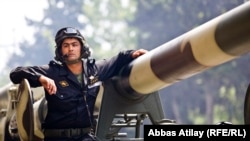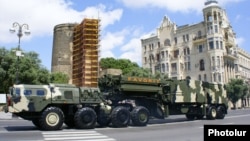-
BAKU, 5 February, 2014. RFE/RL Azerbaijani Service--The International Institute for Strategic Studies (IISS) released The Military Balance 2014, the annual assessment of the military capabilities and defense economics of 171 countries world-wide. According to the report "defence spending in the South Caucasus continues to be dominated by Azerbaijan’s disbursements".
HIGHLIGHTS
According to President Ilham Aliyev, the country’s defence budget increased from US$3bn in 2012 to US$3.7bn in 2013. This funding will enable the replacement of ageing equipment and weapons systems.
Azerbaijan's military procurement falls into three areas:
diversification of Baku’s foreign military cooperation;
equipment purchases;
and efforts to boost domestic production.
Azerbaijan buys equipment from a range of suppliers, developing forms of defence cooperation with a variety of states.
Ukraine was the main source of foreign equipment until a substantial 2012 deal with Russia, which will sell Baku US$4bn-worth of equipment and weapons over three years. Azerbaijan is also reportedly interested in military equipment from South Korea, although details remain unclear. Also important is a related initiative to boost domestic defence production capacity. In 2012, the volume of such production increased by 12% on 2011, and there are now some 700 defence items produced domestically. It is likely, however, that Baku will rely on foreign procurement for high-tech requirements.
Armenia’s 2013 defence budget was US$447m. Although the country’s fledgling domestic defence industry has developed in recent years, it is unlikely to become profitable before 2015 at the earliest, leaving Armenia’s armed forces heavily reliant on a strategic partnership with Russia for upgrades, modernisation and maintenance of its predominantly Russian-manufactured inventory. Small joint ventures with Greece and Poland to modernise T-72 MBTs will mean the country is not completely reliant upon Russia, though contacts with Moscow will likely continue in relation to advanced systems, such as Armenia’s S-300PM air-defence system. Yerevan is interested in enhancing its artillery capabilities, most recently demonstrated by an agreement to procure the Chinese A100 300mm MRL. (A military parade in 2006 showcased an earlier version of this MRL, which appears to have entered service in the 1990s.) Military-technical cooperation with China is unlikely to weaken Moscow’s grip on this market, particularly given Yerevan’s membership of the CSTO and its decision in September 2013 to enter the Customs Union of Belarus, Kazakhstan and Russia.
AZERBAIJAN
"While the armed forces have yet to successfully transition from a Soviet-era model, increasing defence expenditure has provided the opportunity to acquire some more capable military equipment. Rising oil revenues have provided the financial headroom for acquisitions, including the S-300 SAM system, but it is unclear whether the potential benefits brought by these modern systems have been felt in terms of operational capability. The armed forces still rely on conscription, and readiness within the services varies considerably between units. Peacekeeping deployments have included a small number of personnel in Afghanistan. Azerbaijan maintains defence relationships with NATO through an IPAP, and has a close relationship with Turkey. With NATO support, the Internal Troops are developing a police support unit to be available for NATO-led operations. US military assistance has included support to maritimesecurity operations in the Caspian Sea. The air force suffers from training and maintenance problems. The armed forces cannot organically support external deployments.
ACTIVE 66,950 (Army 56,850 Navy 2,200 Air 7,900)
Paramilitary 15,000
Conscript liability 17 months, but can be extended for
ground forces.
RESERVE 300,000
Some mobilisation reported, 300,000 with military service within 15 years
NAGORNO KARBAKH (AZERBAIJAN)
The report also provides information about military capabilitie's of separatist region of Nagorno-Karabakh.
"Available estimates vary with reference to military holdings in Nagorno-Karabakh. Main battle tanks are usually placed at around 200–300 in number, with similar numbers for armoured combat vehicles and artillery pieces, with small numbers of fixed- and rotary-wing aviation. Available personnel number estimates are between 18,000– 20,000."
ARMENIA
Armenia’s armed forces focus on territorial defence, given continuing tensions with neighbouring Azerbaijan. While overall military doctrine remains influenced strongly by Russian thinking, Armenia’s overseas deployments, which include support to ISAF in Afghanistan, enable the troops serving in the Pul-e Khumri PRT to learn lessons from their NATO counterparts.
The ISAF contribution increased in 2011. In November 2011, Armenia signed a new Individual Partnership Action Plan with NATO. While conscription continues, there is a growing cohort of professional officers. The country’s armed forces are generally held to be at least competent and well-motivated. Serviceability and maintenance have been a problem for the air force, and Russia provides national air defence from a leased base.
The army exercises regularly, and aims to be able to deploy and sustain a battalion-sized contingent by 2015 as part of a multinational mission. To inform these developments, Armenia completed a Strategic Defense Review in May 2011.
ACTIVE 44,800 (Army 41,850 Air/AD Aviation
Forces (Joint) 1,100 other Air Defence Forces 1,850)
Paramilitary 4,300
Conscript liability 24 months.
RESERVES some mob reported, possibly 210,000 with military service within 15 years.
BAKU, 5 February, 2014. RFE/RL Azerbaijani Service--The International Institute for Strategic Studies (IISS) released The Military Balance 2014, the annual assessment of the military capabilities and defense economics of 171 countries world-wide. According to the report "defence spending in the South Caucasus continues to be dominated by Azerbaijan’s disbursements".
HIGHLIGHTS
According to President Ilham Aliyev, the country’s defence budget increased from US$3bn in 2012 to US$3.7bn in 2013. This funding will enable the replacement of ageing equipment and weapons systems.
Azerbaijan's military procurement falls into three areas:
diversification of Baku’s foreign military cooperation;
equipment purchases;
and efforts to boost domestic production.
Azerbaijan buys equipment from a range of suppliers, developing forms of defence cooperation with a variety of states.
Ukraine was the main source of foreign equipment until a substantial 2012 deal with Russia, which will sell Baku US$4bn-worth of equipment and weapons over three years. Azerbaijan is also reportedly interested in military equipment from South Korea, although details remain unclear. Also important is a related initiative to boost domestic defence production capacity. In 2012, the volume of such production increased by 12% on 2011, and there are now some 700 defence items produced domestically. It is likely, however, that Baku will rely on foreign procurement for high-tech requirements.
Armenia’s 2013 defence budget was US$447m. Although the country’s fledgling domestic defence industry has developed in recent years, it is unlikely to become profitable before 2015 at the earliest, leaving Armenia’s armed forces heavily reliant on a strategic partnership with Russia for upgrades, modernisation and maintenance of its predominantly Russian-manufactured inventory. Small joint ventures with Greece and Poland to modernise T-72 MBTs will mean the country is not completely reliant upon Russia, though contacts with Moscow will likely continue in relation to advanced systems, such as Armenia’s S-300PM air-defence system. Yerevan is interested in enhancing its artillery capabilities, most recently demonstrated by an agreement to procure the Chinese A100 300mm MRL. (A military parade in 2006 showcased an earlier version of this MRL, which appears to have entered service in the 1990s.) Military-technical cooperation with China is unlikely to weaken Moscow’s grip on this market, particularly given Yerevan’s membership of the CSTO and its decision in September 2013 to enter the Customs Union of Belarus, Kazakhstan and Russia.
AZERBAIJAN
"While the armed forces have yet to successfully transition from a Soviet-era model, increasing defence expenditure has provided the opportunity to acquire some more capable military equipment. Rising oil revenues have provided the financial headroom for acquisitions, including the S-300 SAM system, but it is unclear whether the potential benefits brought by these modern systems have been felt in terms of operational capability. The armed forces still rely on conscription, and readiness within the services varies considerably between units. Peacekeeping deployments have included a small number of personnel in Afghanistan. Azerbaijan maintains defence relationships with NATO through an IPAP, and has a close relationship with Turkey. With NATO support, the Internal Troops are developing a police support unit to be available for NATO-led operations. US military assistance has included support to maritimesecurity operations in the Caspian Sea. The air force suffers from training and maintenance problems. The armed forces cannot organically support external deployments.
ACTIVE 66,950 (Army 56,850 Navy 2,200 Air 7,900)
Paramilitary 15,000
Conscript liability 17 months, but can be extended for
ground forces.
RESERVE 300,000
Some mobilisation reported, 300,000 with military service within 15 years
NAGORNO KARBAKH (AZERBAIJAN)
The report also provides information about military capabilitie's of separatist region of Nagorno-Karabakh.
"Available estimates vary with reference to military holdings in Nagorno-Karabakh. Main battle tanks are usually placed at around 200–300 in number, with similar numbers for armoured combat vehicles and artillery pieces, with small numbers of fixed- and rotary-wing aviation. Available personnel number estimates are between 18,000– 20,000."
ARMENIA
Armenia’s armed forces focus on territorial defence, given continuing tensions with neighbouring Azerbaijan. While overall military doctrine remains influenced strongly by Russian thinking, Armenia’s overseas deployments, which include support to ISAF in Afghanistan, enable the troops serving in the Pul-e Khumri PRT to learn lessons from their NATO counterparts.
The ISAF contribution increased in 2011. In November 2011, Armenia signed a new Individual Partnership Action Plan with NATO. While conscription continues, there is a growing cohort of professional officers. The country’s armed forces are generally held to be at least competent and well-motivated. Serviceability and maintenance have been a problem for the air force, and Russia provides national air defence from a leased base.
The army exercises regularly, and aims to be able to deploy and sustain a battalion-sized contingent by 2015 as part of a multinational mission. To inform these developments, Armenia completed a Strategic Defense Review in May 2011.
ACTIVE 44,800 (Army 41,850 Air/AD Aviation
Forces (Joint) 1,100 other Air Defence Forces 1,850)
Paramilitary 4,300
Conscript liability 24 months.
RESERVES some mob reported, possibly 210,000 with military service within 15 years.







